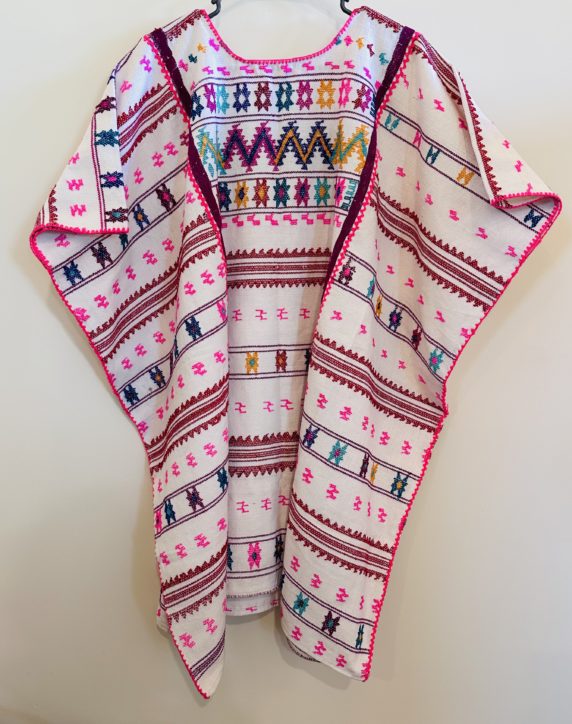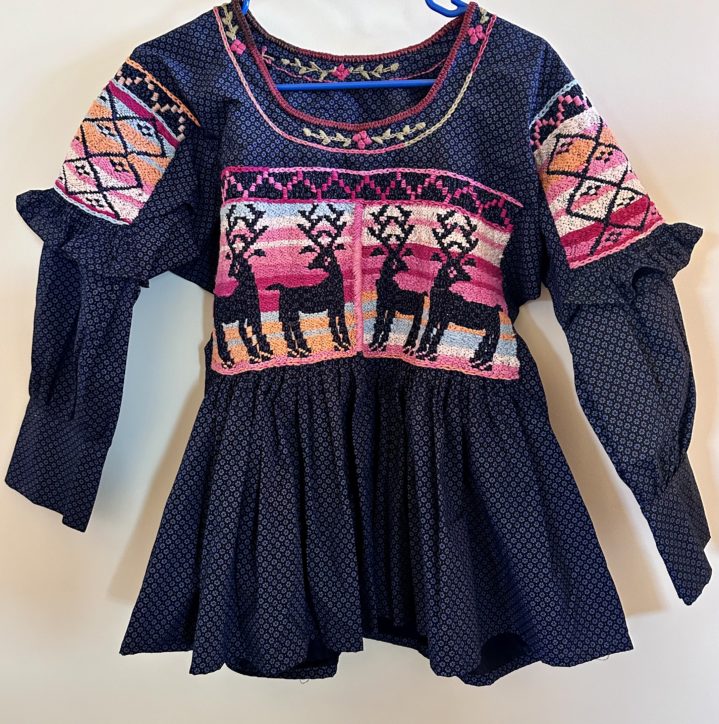Scott Roth and I have been friends for about 15 years. I met him a few years after I first arrived in Teotitlan del Valle, Oaxaca, in 2005. Scott is a legend. He is one of the early adventurers who identified the weaving talent in the village, and intuited that blankets and rugs could be repurposed into beautiful floor rugs with just a few modifications. He began working with a few weavers on designs and dyes for export to the USA to meet the nascent interest in what became known as Southwest Style. I want to tell his story, because it is an important part of the history of what Oaxaca is today. I’ll be publishing his writing in segments along with his photos.
1970’s Transition from Wearable Serapes to Floor Rugs
These are Scott’s words!
I first visited the village in January 1974, and returned in August and November that year to continue investing in their two-piece blankets (serapes) and wall hangings. At the time, there was only one man, Ismael Gutierrez, making textiles we would consider rugs today, with the tightness of weave that we find suitable for heavy foot traffic.

Above: Blanket, Scott Roth Collection, era 1974
The big surge of popularity of these weavings was just around the bend, when the Southwest design trend came on strong in 1980. In 1974, there were only two other Americans regularly coming to Teotitlan as exporters, but shortly thereafter ten fellow hippy boomers discovered the village, and found a way, like myself, to fund a romantically adventurous lifestyle.


Above Left: Flor de Oaxaca. Above Right: Escher tapestry
As is now in Teotitlan del Valle, most households strived to become financially independent, creating for the marketplace a unique wool textile through design, size, function and color palette. There was a wide range of images displayed by Teotitecos at the weekly Sunday Tlacolula Market, and also at Saturday’s market in Oaxaca city, which was a block from the Zocalo, on the streets facing the Benito Juarez Market.

Above: Aztec Calendar, 1930’s
In 1974, some of the prominent themes depicted in the tapestry weaving were based on the 1910-1920 Mexican Revolution, during which time greater civil rights and land reforms uplifted indigenous groups. These themes included figures from pre-Hispanic carvings of anthropomorphic gods and the very popular rendering of the stone-carved Aztec Calendar. These themes originated in the 1930’s and remained well into the 1970’s. Weavers of this era learned from their grandfathers who were the serape makers during the mid-1800’s when colonial period Saltillo-style serapes were in vogue throughout Mexico. A pattern from that pre-Revolution era, named Flor de Oaxaca, was the singular most popular design for the 5′ x 6-1/2′ two-piece serapes in 1975. It was a simplified version which fit in with mid-century modernist aesthetic.

Above: Saltillo-style serape, Flor de Oaxaca design, Teotitlan del Valle
Early 20th century European modern art readily translated to tapestries, with many interpretations of Miro, Picasso, M.C. Escher, and Matisse found alongside pre-Columbian figures. Isaac Vasquez (who died in 2022) told me how he wove commissioned tapestries for Rufino Tamayo, at the time Mexico’s most famous living artist. In the early sixties, Tamayo brought along his good friend from Paris, Pablo Picasso. Picasso drew for Isaac a simple design of fish stacked in opposing directions like canned sardines. The design, Pescados Modernas, became one of the village’s most enduring best sellers.


Above: Picasso’s fish interpreted for Teotitlan del Valle tapestries

Above: Matisse tapestry, Teotitlan del Valle, 1970’s
Pre-Hispanic figures from two books by Mexican anthropologist/designer Jorge Enciso, called escaletos, were the subject of favored small wall hangings, in black and white wool. If you know the 1980’s New York City pop artist Keith Haring, you know the power of tightly balanced positive and negative figurative work. I suspect Haring was influenced by the pre-Hispanic figures in Teotitlán’s Escaleto tapestries.

Above: Jose Enciso designs replicated in Teotitlan weaving
There was a remarkable contrast between the bare minimum of material goods in any household and the highly spirited social exchanges one observed on the street. Everyone slept on the dirt floor of their one-room adobe house, unrolling a petate every night. There was only one car in town, no running water or plumbing, no paved streets, most women over age 50 went barefoot, and people over 40 had a very limited grasp of Spanish. Electricity had arrived in 1965, but was used minimally. I enjoyed visiting two households in which one weaver would, unaccompanied, sing songs for hours while he and other family members continued working on their looms. A lively and cheery work environment! A few years later the Teotitecos could afford cassette stereos, and this tradition of singing disappeared.

Above: 1950’s-60’s Modernist home with Flor de Oaxaca rug on the floor
The next post will cover the decade of the 1980’s, when everything changed materially. In retrospect, I observed in the 1970’s that much of the Zapotec lifestyle here had been as it was through the colonial period. A good, but hard to find, anthropological study of the value system of the Oaxaca Valley Zapotecs was published in the late sixties titled Zapotec Deviance. It contains insights as to what has helped maintain their cultural identity and sustainability this last half century.
Here is a video interview with Scott you may enjoy!
Norma’s Note: I’ve lightly edited Scott’s narrative and photos, and inserted a few more details, like the recent death of Isaac Vasquez, innovative master weaver. Also of note, the colorful rugs shown here were made with churro sheep wool and chemical (synthetic) dyes, popular at the time, because they were cheap and easy to use. Before the industrial revolution in the mid-1800’s, serapes here were either made from the natural sheep wool (blacks, grays, beige, white, brown) or with natural dyes from local plant sources (cochineal, indigo, wild marigold, tree bark).




Above: This is master weaver Adrian Montaño from Teotitlan del Valle. He wove a vintage Covarrubias design in the 1960’s that I purchased in 2020. It hangs in my Teotitlan del Valle casita. Other examples from that era are included, and woven by him. The last photos is a traditional design created by Eric Chavez Santiago’s great grandfather Venustiano, popularized throughout the village. All in natural sheep wool.




































Names
Federico Chavez Sosa: People here have at least two family names. The first last name is the father’s name followed by the mother’s name. Federico’s father was Jose Chavez Ruiz and his wife is Soledad Sosa XXX. Federico’s wife is Dolores Santiago Arellanas. Their children are Eric Chavez Santiago, Janet Chavez Santiago and Omar Chavez Santiago; they carry both their father’s and mother’s names. This is helpful and important in a village where many share the same surnames. So, for example, there several people who are named Eric Chavez, but only one Eric Chavez Santiago. There is a distant cousin named Eric Chavez Sosa, so it is important to be clear about the distinctions in order to find the people you are looking for. Take, for another example, Josefina Ruiz Vasquez, the owner/operator of Las Granadas bed and breakfast. She was married to Eligio Bazan Ruiz, who died almost three years ago at age 38 of cancer. He was a master weaver who traveled with Scott Roth throughout the United States exhibiting rugs and making some of the finest work of the village. When Eligio died, Josefina had no livelihood. She was living with her mother in law, Eligio’s mother, Magdalena, in her husband’s family home. Josefina has three children, Eloisa Francesca Bazan Ruiz, Willibaldo Bazan Ruiz, and Eligio Bazan Ruiz.
According to HarperCollins Dictionary…..
nombre de pila, noun
first name
The pila referred to here is the font in which Christian children are traditionally baptized.
Most of the first names in Spain have some kind of Christian associations. It’s not uncommon for a boy to be called Jesús (with an accent) after Jesus, or José, after Joseph. It’s equally common for a girl to be named María, after the Virgin Mary. There is also a tendency to sandwich names together, making combinations like José María (for a boy) or María Jesús (for a girl).
Though a lot of these names are used in Latin America, you are also more likely to come across names which do not have any specific religious associations.
Like this:
Comments Off on Names
Posted in Cultural Commentary, Teotitlan del Valle
Tagged Dolores Santiago Arellanas, Eligio Bazan Ruiz, Eric Chavez Santiago, Federico Chavez Sosa, Josefina Ruiz Vasquez, Las Granadas B&B, Mexican names, Scott Roth